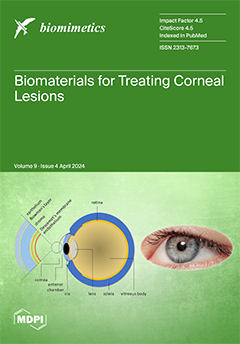β-tricalcium phosphate (β-TCP) is a promising material in regenerative traumatology for the creation of bone implants. Previously, it was established that doping the structure with certain cations can reduce the growth of bacterial activity. Recently, much attention has been paid to co-doped β-TCP,
[...] Read more.
β-tricalcium phosphate (β-TCP) is a promising material in regenerative traumatology for the creation of bone implants. Previously, it was established that doping the structure with certain cations can reduce the growth of bacterial activity. Recently, much attention has been paid to co-doped β-TCP, that is explained by their ability, on the one hand, to reduce cytotoxicity for cells of the human organism, on the other hand, to achieve a successful antibacterial effect. Sr, Cu-co-doped solid solutions of the composition Ca
9.5–xSr
xCu(PO
4)
7 was obtained by the method of solid-phase reactions. The Rietveld method of structural refinement revealed the presence of Sr
2+ ions in four crystal sites: M1, M2, M3, and M4. The M5 site is completely occupied by Cu
2+. Isomorphic substitution of Ca
2+ → (Sr
2+and Cu
2+) expands the concentration limits of the existence of the solid solution with the β-TCP structure. No additional phases were formed up to
x = 4.5 in Ca
9.5–xSr
xCu(PO
4)
7. Biocompatibility tests were performed on cell lines of human bone marrow mesenchymal stromal cells (hMSC), human fibroblasts (MRC-5) and osteoblasts (U-2OS). It was demonstrated that cytotoxicity exhibited a concentration dependence, along with an increase in osteogenesis and cell proliferation. Ca
9.5–xSr
xCu(PO
4)
7 powders showed significant inhibitory activity against pathogenic strains Escherichia coli and Staphylococcus aureus. Piezoelectric properties of Ca
9.5–xSr
xCu(PO
4)
7 were investigated. Possible ways to achieve high piezoelectric response are discussed. The combination of bioactive properties of Ca
9.5–xSr
xCu(PO
4)
7 renders them multifunctional materials suitable for bone substitutes.
Full article


